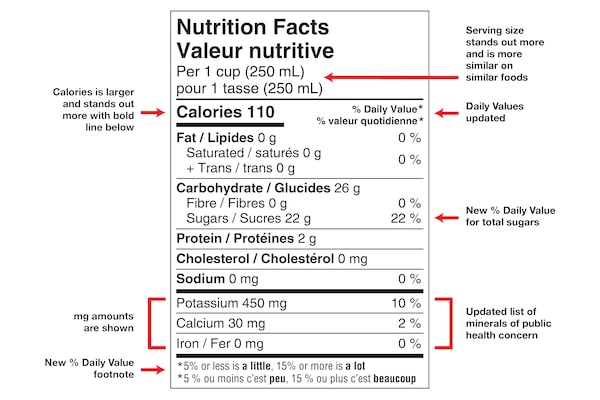
The Nutrition Facts table.The Globe and Mail
On June 30, Health Canada announced new nutrition labelling regulations that will require prepackaged foods high in saturated fat, sugars and/or sodium to display a front-of-package symbol highlighting this information.
Research from other countries has found that such easy-to-understand front-of-package labels can guide consumers to make healthier food choices.
The front-of-package “high-in” symbol will complement the back-of-package Nutrition Facts table, which has been mandatory since 2007. Food manufacturers have until January 1, 2026 to comply with the new regulations.
What is the anti-inflammatory diet plan?
In the meantime, the following tips can help you make sense of the Nutrition Facts table – and apply that information to your personal diet.
(Note: In December 2016, Health Canada announced improvements to the Nutrition Facts table and ingredient list, a few of which I mention below. While these updates won’t be fully in effect until December 2023, many food companies have already applied them to product labels.)
Check serving size
In order to know how much protein, fibre, sugar or sodium, for example, you’re consuming, look at the serving size and compare that amount to how much you actually eat.
Serving sizes on the updated Nutrition Facts table better reflect the amount of food that’s typically eaten in one sitting. They’re also more consistent across products, making it easier to compare similar foods for calories and nutrients.
Understand sugar numbers
The amount of sugars (grams) on the Nutrition Facts table lumps together free sugars and naturally-occurring sugars (e.g., lactose in milk and fructose in fruit). By doing so, the sugar information doesn’t tell you how much of it was added by the food industry.
You can assume, though, that for a product that doesn’t contain any dairy or dried fruit, the amount of sugars listed will be free sugars. For perspective, four grams of sugar is equivalent to one teaspoon worth.
The right mix for longevity: three vegetable and two fruit servings a day
Typically, a 100 g single serving of vanilla- or fruit-flavoured yogurt contains 11 to 12 g of total sugars. About 8 g are free sugars and the remaining is naturally-occurring lactose. For plain yogurt, all of the sugar listed is natural sugar.
Free sugars are added sugars as well as sugars naturally present in fruit juice and fruit juice concentrates. Once removed from whole fruit, these sugars are “free” to be added to foods for sweetening purposes.
Use daily value (DV) percentages
The DV percentages, on the right-hand side of the Nutrition Facts table, are useful to get a sense of how much of a nutrient is in one serving of the product.
Five per cent or less of the DV is considered a little and 15 per cent or more is considered a lot.
A low per cent DV is a good thing for nutrients you want to limit (e.g., sodium, sugars). For nutrients you may want to consume more of (e.g., fibre, potassium, calcium), look for higher DV percentages.
Daily values are based on recommended daily intakes, which are age- and gender-specific daily nutrient requirements. For saturated fat, trans fat and sodium, consider these DVs as upper intake limits.
The DV for total sugars has been set at 100 g, an amount that’s consistent with a healthy diet where most of the total sugars come from fruits, vegetables and unsweetened dairy.
Read the ingredient list
Ingredients are listed in descending order by weight. The first or heaviest ingredient is what the product contains the most of.
The ingredient list has been updated so that all free sugar ingredients are grouped together under the common name “Sugars”. The placement of Sugars in the ingredient list will depend on the total weight of the combined sugar ingredients.
The list of ingredients gives an overall sense of a product’s nutritional quality. Ideally, choose products that list whole foods as the first three ingredients.
Don’t be fooled by ingredients that sound healthier than they are such as wheat flour (refined white flour), fruit juice concentrate (a free sugar) and brown rice syrup (a free sugar).
Think big picture
The Nutrition Facts box and ingredients list provide useful information to help you make healthier food choices, but don’t get too bogged down with certain numbers or percentages.
Consider the overall nutritional quality of food products, too, especially for ones that are part of your regular diet.
Just because one product has fewer calories or carbohydrates, for example, doesn’t mean that it’s a good source of beneficial nutrients or that it doesn’t contain unwanted ingredients.
Leslie Beck, a Toronto-based private practice dietitian, is director of food and nutrition at Medcan. Follow her on Twitter @LeslieBeckRD
Sign up for the weekly Health & Wellness newsletter for the latest news and advice.